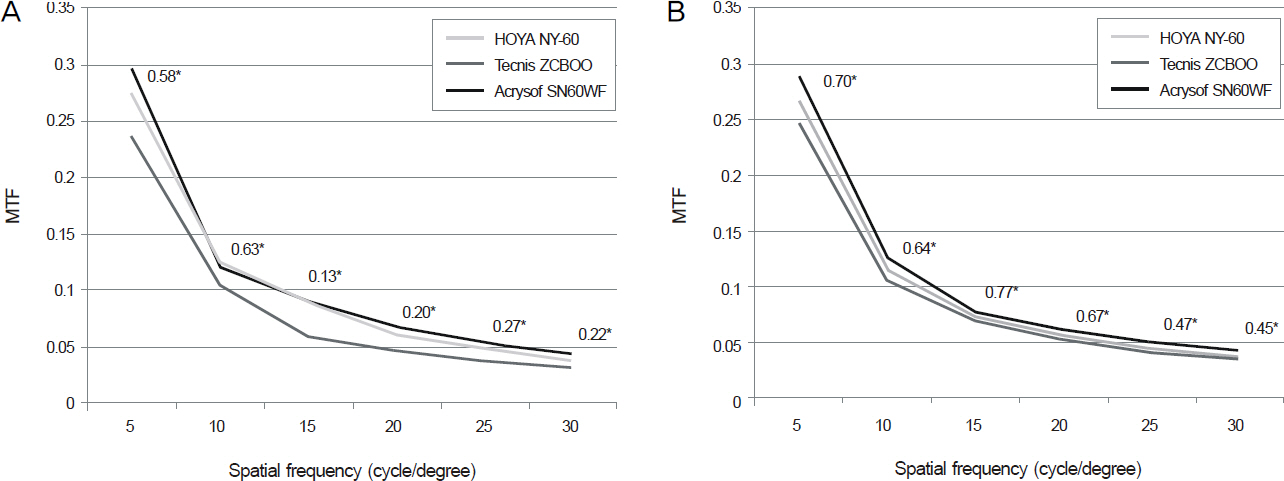J Korean Ophthalmol Soc.
2013 Feb;54(2):251-256. 10.3341/jkos.2013.54.2.251.
Comparisons of Clinical Results after Implantation of Three Aspheric Intraocular Lenses
- Affiliations
-
- 1The Institute of Vision Research, Department of Ophthalmology, Yonsei University College of Medicine, Seoul, Korea. TIKIM@yuhs.ac
- KMID: 2216660
- DOI: http://doi.org/10.3341/jkos.2013.54.2.251
Abstract
- PURPOSE
To compare the clinical results after implantation of three one-piece aspheric lenses, Acrysof IQ SN60WF, Tecnis 1-piece ZCB00 and the newly developed IOL HOYA AF-1 NY-60.
METHODS
In total 66 eyes, one of three one-piece aspheric lenses, Acrysof IQ SN60WF, TECNIS 1-piece ZCB00 or HOYA AF-1 NY-60 was implanted after cataract extraction. Best corrected visual acuity (BCVA) and uncorrected visual acuity (UCVA) were assessed at postoperative 3 months. Total spherical aberration, high order aberration and modulation transfer function of 5.0 mm pupil size zone were evaluated.
RESULTS
There were no significant differences of UCVA, BCVA, the accuracy of postoperative refractive power and modulation transfer function among three groups. High order aberrations of the entire eye and internal optics showed almost no significant differences except some aberration values.
CONCLUSIONS
The newly developed intraocular lens, HOYA AF-1 NY-60 showed almost equal clinical results in comparison with Acrysof IQ SN60WF and TECNIS 1-piece ZCB00.
Figure
Cited by 2 articles
-
Comparison of Clinical Long-Term Outcomes with Two Types of One-Piece Aspheric Intraocular Lenses after Cataract Surgery
Yong Seok Park, Yong Sok Ji, Kyung Chul Yoon
J Korean Ophthalmol Soc. 2016;57(2):221-227. doi: 10.3341/jkos.2016.57.2.221.Comparing Clinical Results after Intraocular Lens Implantation Surgery Using Three Other Aspheric Lenses
Byung Hoon Chung, Ji Won Jung, Hyung Keun Lee, Kyoung Yul Seo, Eung Kweon Kim, Tae Im Kim
J Korean Ophthalmol Soc. 2015;56(4):541-547. doi: 10.3341/jkos.2015.56.4.541.
Reference
-
References
1. Grabow HB. Topical anesthesia for cataract surgery. Eur J Implant Ref Surg. 1993; 5:20–4.2. Gimbel HV, Neuhann T. Development, advantages, and methods of the continuous circular capsulorhexis technique. J Cataract Refract Surg. 1990; 16:31–7.
Article3. Dogru M, Honda R, Omoto M, et al. Early visual results with the rollable ThinOptX intraocular lens. J Cataract Refract Surg. 2004; 30:558–65.
Article4. Pandey SK, Werner L, Agarwal A, et al. Phakonit: cataract removal through a sub-1.0 mm incision and implantation of the ThinOptX rollable intraocular lens. J Cataract Refract Surg. 2002; 28:1710–3.
Article5. Werner L, Mamalis N. Wavefront corrections of intraocular lenses. Ophthalmol Clin North Am. 2004; 17:233–45.
Article6. Chalita MR, Krueger RR. Correlation of aberrations with visual acuity and symptoms. Ophthalmol Clin North Am. 2004; 17:135–42.
Article7. Guirao A, Redondo M, Geraghty E, et al. Corneal optical aberrations and retinal image quality in patients whom monofocal intraocular lenses were implanted. Arch Ophthalmol. 2002; 120:1143–51.8. Guirao A, Redondo M, Artal P. Optical aberrations of the human cornea as a function of age. J Opt Soc Am A Opt Image Sci Vis. 2000; 17:1697–702.
Article9. McLellan JS, Marcos S, Burns SA. Age-related changes in monochromatic wave aberrations of the human eye. Invest Ophthalmol Vis Sci. 2001; 42:1390–5.10. Oshika T, Klyce SD, Applegate RA, Howland HC. Changes in cor-neal wavefront aberrations with aging. Invest Ophthalmol Vis Sci. 1999; 40:1351–5.11. Artal P, Berrio E, Guirao A, Piers P. Contribution of the cornea and internal surfaces to the change of ocular aberrations with age. J Opt Soc Am A Opt Image Sci Vis. 2002; 19:137–43.
Article12. Artal P, Guirao A, Berrio E, Williams DR. Compensation of cor-neal aberrations by the internal optics in the human eye. J Vis. 2001; 1:1–8.
Article13. Caporossi A, Martone G, Casprini F, Rapisarda L. Prospective randomized study of clinical performance of 3 aspheric and 2 spherical intraocular lenses in 250 eyes. J Refract Surg. 2007; 23:639–48.
Article14. Rocha KM, Soriano ES, Chalita MR, et al. Wavefront analysis and contrast sensitivity of aspheric and spherical intraocular lenses : a randomized prospective study. Am J Opthalmol. 2006; 142:750–6.15. Tzelikis PF, Akaishi L, Trindade FC, Boteon JE. Spherical aberration and contrast sensitivity in eyes implanted with aspheric and spherical intraocular lenses: a comparative study. Am J Ophthalmol. 2008; 145:827–33.
Article16. Lim TH, Lee JR, Choi KY, Cho BJ. Anterior and posterior corneal spherical aberration measured with pentacam in the Korean. J Korean Ophthalmol Soc. 2010; 51:816–21.
Article17. Petermeier K, Frank C, Gekeler F, et al. Influence of the pupil size on visual quality and spherical aberration after implantation of the Tecnis 1-piece intraocular lens. Br J Ophthalmol. 2011; 95:42–5.
Article
- Full Text Links
- Actions
-
Cited
- CITED
-
- Close
- Share
- Similar articles
-
- Comparison of Nd:YAG Capsulotomy Rates between Spherical and Aspheric Intraocular Lenses
- Comparing Clinical Results after Intraocular Lens Implantation Surgery Using Three Other Aspheric Lenses
- Comparisons of Clinical Results after Implantation of Three Aspheric Intraocular Lenses
- Comparison of Nd:YAG Laser Capsulotomy Rates between Implantation of Two Different Aspheric Intraocular Lenses
- Comparisons of Visual Acuity, Spherical Aberration and Contrast Sensitivity among Spheric, Aspheric ReSTOR(R), and Crystalens HD(R) Lenses


